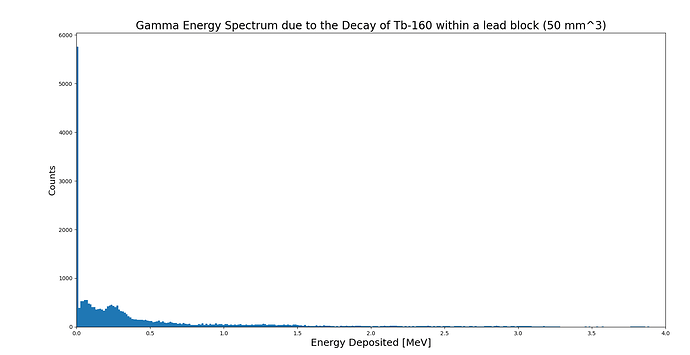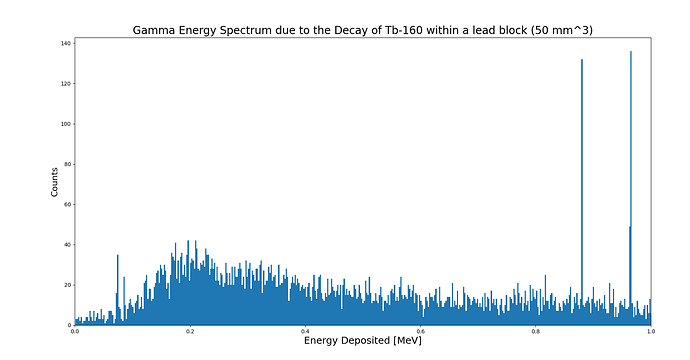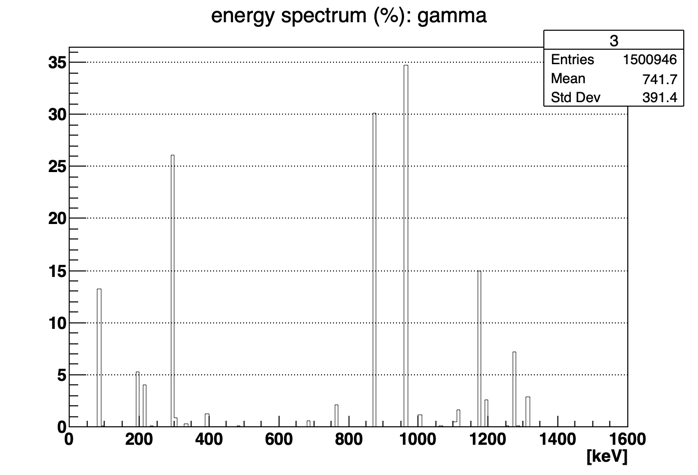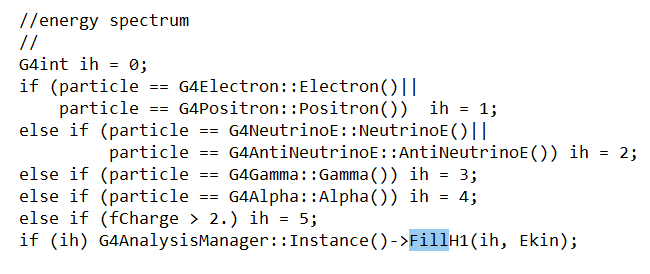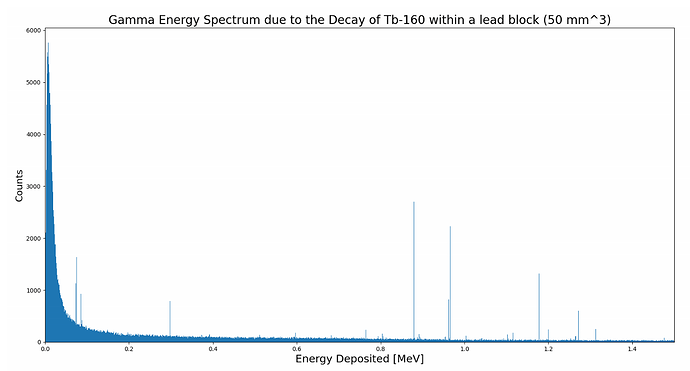Hi Maire,
Thank you for your reply.
I ran the macro file and got the following;
#class tools::histo::h1d
#title energy spectrum (%): gamma
#dimension 1
#axis fixed 160 0 1600
#annotation axis_x.title [keV]
#bin_number 162
entries,Sw,Sw2,Sxw0,Sx2w0
0,0,0,0,0
34446,34.446,0.034446,147.041,864.552
95105,95.105,0.095105,1124.52,13478
33,0.033,3.3e-05,0.813439,20.2636
21,0.021,2.1e-05,0.719122,24.8384
17483,17.483,0.017483,800.478,36653.4
4324,4.324,0.004324,226.921,11910.5
1,0.001,1e-06,0.0615839,3.79258
92056,92.056,0.092056,6850.97,509967
38498,38.498,0.038498,3313.23,285189
100,0.1,0.0001,9.67735,937.36
1125,1.125,0.001125,119.182,12632.3
1157,1.157,0.001157,132.867,15267.5
1080,1.08,0.00108,134.798,16834
989,0.989,0.000989,133.304,17975.7
882,0.882,0.000882,127.914,18558.3
734,0.734,0.000734,113.712,17622.6
654,0.654,0.000654,107.764,17762.4
572,0.572,0.000572,100.058,17507.6
485,0.485,0.000485,89.705,16596
5717,5.717,0.005717,1125.52,221591
399,0.399,0.000399,81.8354,16787.9
4349,4.349,0.004349,937.539,202114
333,0.333,0.000333,74.8581,16830.7
405,0.405,0.000405,94.7233,22158.3
308,0.308,0.000308,75.3952,18458.2
291,0.291,0.000291,74.0844,18863
220,0.22,0.00022,58.2797,15440.7
243,0.243,0.000243,66.7908,18360.1
184,0.184,0.000184,52.4407,14947.4
26296,26.296,0.026296,7850.68,2.34383e+06
1022,1.022,0.001022,315.638,97487
144,0.144,0.000144,45.2969,14249.8
139,0.139,0.000139,45.1152,14644.1
394,0.394,0.000394,132.722,44709.3
113,0.113,0.000113,39.0186,13474.2
97,0.097,9.7e-05,34.4315,12222.6
101,0.101,0.000101,36.8614,13454.1
100,0.1,0.0001,37.5472,14098.8
96,0.096,9.6e-05,36.9775,14243.9
1413,1.413,0.001413,554.827,217859
75,0.075,7.5e-05,30.411,12331.7
79,0.079,7.9e-05,32.7866,13607.6
63,0.063,6.3e-05,26.7704,11376
65,0.065,6.5e-05,28.2324,12263.1
57,0.057,5.7e-05,25.3558,11279.7
47,0.047,4.7e-05,21.3742,9720.72
45,0.045,4.5e-05,20.9401,9744.64
47,0.047,4.7e-05,22.3095,10589.9
108,0.108,0.000108,52.4322,25455.3
41,0.041,4.1e-05,20.295,10046.3
30,0.03,3e-05,15.1558,7656.84
372,0.372,0.000372,190.28,97330
32,0.032,3.2e-05,16.8029,8823.29
31,0.031,3.1e-05,16.588,8876.43
25,0.025,2.5e-05,13.629,7430.23
29,0.029,2.9e-05,16.0978,8936.07
29,0.029,2.9e-05,16.3858,9258.57
23,0.023,2.3e-05,13.234,7614.94
23,0.023,2.3e-05,13.4603,7877.54
25,0.025,2.5e-05,14.8498,8820.79
20,0.02,2e-05,12.1017,7322.73
12,0.012,1.2e-05,7.38099,4540.01
12,0.012,1.2e-05,7.51851,4710.75
15,0.015,1.5e-05,9.49241,6007.11
13,0.013,1.3e-05,8.38604,5409.79
9,0.009,9e-06,5.88916,3853.65
11,0.011,1.1e-05,7.3127,4861.53
10,0.01,1e-05,6.74821,4553.91
615,0.615,0.000615,419.644,286343
4,0.004,4e-06,2.77917,1930.96
17,0.017,1.7e-05,12.0148,8491.61
6,0.006,6e-06,4.29721,3077.72
5,0.005,5e-06,3.63003,2635.45
5,0.005,5e-06,3.66977,2693.45
6,0.006,6e-06,4.46822,3327.57
4,0.004,4e-06,3.00946,2264.22
2134,2.134,0.002134,1633.11,1.24978e+06
4,0.004,4e-06,3.10962,2417.47
6,0.006,6e-06,4.7045,3688.77
2,0.002,2e-06,1.58842,1261.58
5,0.005,5e-06,4.03221,3251.77
5,0.005,5e-06,4.06479,3304.52
4,0.004,4e-06,3.29897,2720.83
7,0.007,7e-06,5.84056,4873.25
0,0,0,0,0
3,0.003,3e-06,2.56514,2193.32
4,0.004,4e-06,3.45977,2992.51
30151,30.151,0.030151,26512.5,2.33131e+07
1,0.001,1e-06,0.882624,779.025
0,0,0,0,0
0,0,0,0,0
0,0,0,0,0
2,0.002,2e-06,1.84317,1698.64
0,0,0,0,0
0,0,0,0,0
0,0,0,0,0
34766,34.766,0.034766,33552.3,3.23811e+07
1,0.001,1e-06,0.973374,947.457
0,0,0,0,0
0,0,0,0,0
1234,1.234,0.001234,1237.67,1.24134e+06
0,0,0,0,0
0,0,0,0,0
0,0,0,0,0
0,0,0,0,0
0,0,0,0,0
104,0.104,0.000104,111.181,118858
0,0,0,0,0
0,0,0,0,0
0,0,0,0,0
466,0.466,0.000466,513.826,566561
1649,1.649,0.001649,1838.86,2.05058e+06
1,0.001,1e-06,1.12208,1259.07
0,0,0,0,0
0,0,0,0,0
0,0,0,0,0
1,0.001,1e-06,1.16821,1364.71
14776,14.776,0.014776,17405.5,2.05028e+07
0,0,0,0,0
2656,2.656,0.002656,3186.91,3.82395e+06
0,0,0,0,0
0,0,0,0,0
0,0,0,0,0
0,0,0,0,0
0,0,0,0,0
80,0.08,8e-05,100.106,125264
0,0,0,0,0
7153,7.153,0.007153,9097.73,1.15712e+07
99,0.099,9.9e-05,127.274,163623
8,0.008,8e-06,10.3973,13513
0,0,0,0,0
2827,2.827,0.002827,3709.51,4.8675e+06
0,0,0,0,0
0,0,0,0,0
0,0,0,0,0
0,0,0,0,0
0,0,0,0,0
0,0,0,0,0
0,0,0,0,0
0,0,0,0,0
0,0,0,0,0
0,0,0,0,0
0,0,0,0,0
0,0,0,0,0
0,0,0,0,0
0,0,0,0,0
0,0,0,0,0
0,0,0,0,0
0,0,0,0,0
0,0,0,0,0
0,0,0,0,0
0,0,0,0,0
0,0,0,0,0
0,0,0,0,0
0,0,0,0,0
1,0.001,1e-06,1.55658,2422.95
0,0,0,0,0
0,0,0,0,0
0,0,0,0,0
0,0,0,0,0
0,0,0,0,0
I can see you are using root to create these plots however, I dont have access to root, therefore I am using python to create the plots.
I know that Sw indicates the sum of weights, Sw2 the sum of weights squared, Sxw0 the sum of weights times bin number and finally Sx2w0 the sum of weights times bin number squared. Can you tell me how you were able to plot this spectrum using the above information? Am I right in saying that the weight corresponds to the absorbed energy of a particle in a sensitive detector?
Kind Regards,
Jason.
